We are busy people with lots to do and only 24 hours a day to squeeze it all in. Where can yoga fit in to an already overcrowded schedule?
Maybe a 60- or 90-minute class isn’t effortlessly merging with your existing schedule, or perhaps the class offerings near you are not at convenient times. It could be that your fitness or mindfulness routines are already full and adding yoga, though you want to, seems like it would be just one more thing to complicate life.
But here’s some good news: Establishing and committing to a yoga practice does not have to require a lot of time each day. Of course, the more often you do yoga, you will find your body wanting more of it, and other things that may have once been barriers to your yoga practice will fall away to make room. It really can be that transformative.
If you’re at the point in your life where you are ready to start practicing but don’t know where to begin, rest assured that finding yoga won’t be difficult. After all, yoga studios are becoming more abundant, even in remote areas, and most local gyms offer classes throughout the week. Health and wellness centers, clinics, senior centers, community centers and public libraries, too, very likely will offer one or two weekly yoga classes for the public. You may even be able to find a class at a local park.
10-minute Home Practice Sequence
Here is a foundational home sequence to incorporate into your yoga routine.
Mountain Pose (Tadasana)
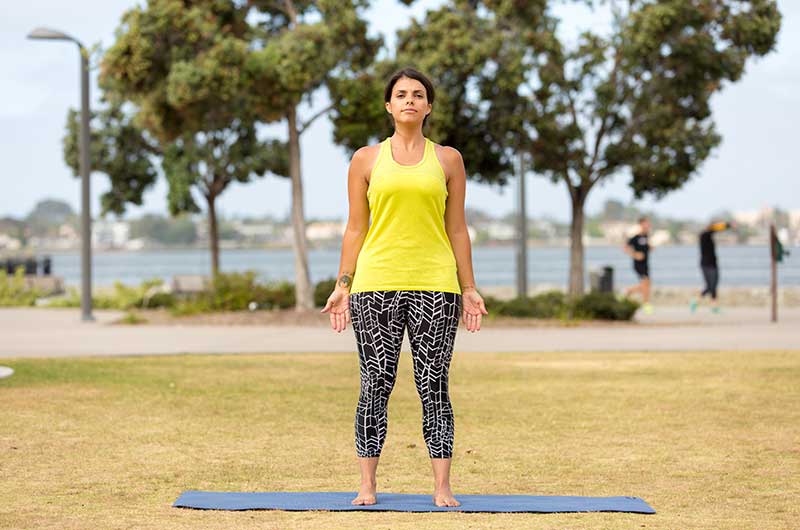
Begin standing, feet hip-width apart. Bring your arms alongside your body, your fingers reaching to the floor. Engage your abdominals and lengthen your spine. Tighten your thighs and loosen your buttocks. Breathe in this pose for at least five complete rounds of breath.
Warrior 2 (Virabhadrasana II)

From Mountain Pose, step your left foot back into a wide stance, turning your left foot to a 45-degree angle. Extend your arms so that your fingertips are reaching out over your toes. Bend your right knee to bring your knee over your ankle. Stay tall in your spine, sinking into your tailbone. Hold for three to five breaths before switching sides.
Side Angle (Utthita Parsvakonasana)

From Warrior II with your right foot forward, lightly rest your right forearm on your right thigh. Extend your left arm to the ceiling, rotating your torso and left hip upwards. Continue sinking into your hips with your right knee bent so it is in line with your right ankle. Hold for three to five breaths and then switch sides.
Tree Pose (Vriksasana)
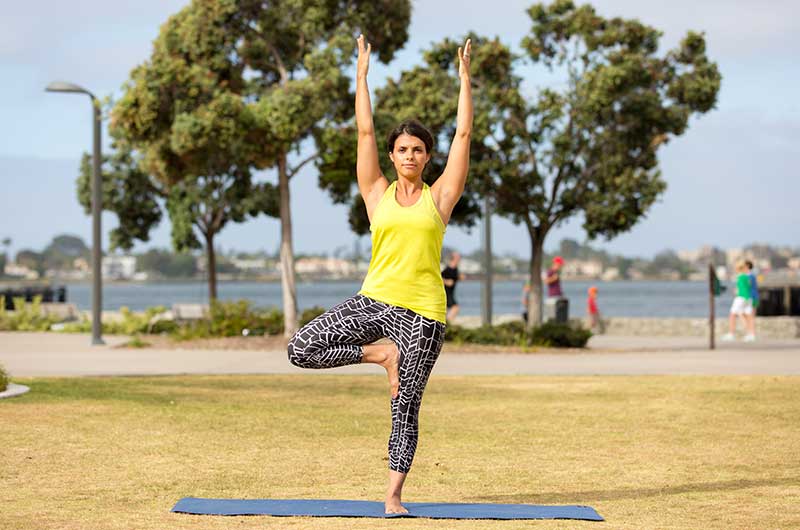
From Mountain Pose, transfer your weight into your left leg and bring your right foot to the inside of your left ankle, shin or inner thigh. Avoid the knee joint. Pull your right knee to the wall behind you to open up your hip. Stand tall and extend your arms overhead; relax your shoulders. Hold for three to five breaths and then switch sides.
Standing Wide-legged Forward Bend With Twist (Parivritta Prasarita Padottanasana)
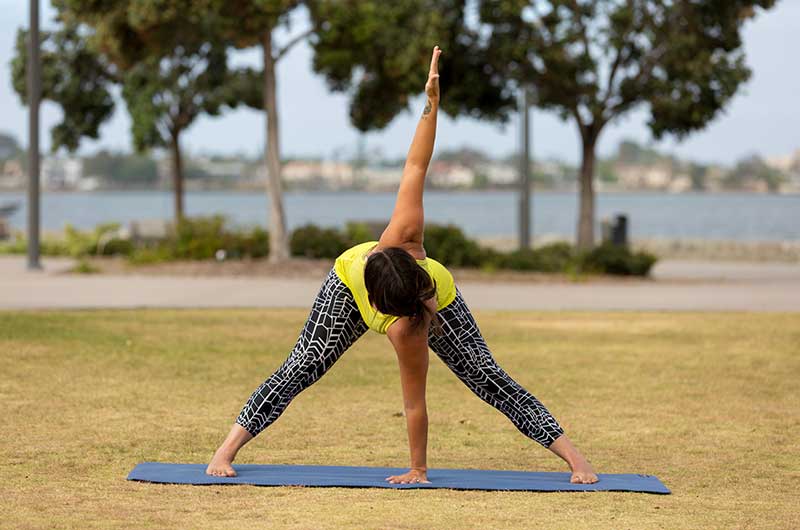
From Mountain Pose, step your left foot back into a wide stance. Pull your toes forward, so the edges of your feet are parallel to the short edges of your mat. Stand tall, engaging your thighs. Bring your hands to your hips. Inhale to lengthen your spine. Exhale and fold from your hip joint toward the floor. Bring your hands to the floor or to a yoga block. Flatten your back. Inhale and float your right arm up toward the ceiling, keeping your hips square and your thighs engaged. Hold for three to five breaths. Exhale the right hand down. Inhale the left arm to the ceiling. Hold for three to five breaths. Exhale and release.
Low lunge (Anjaneyasana)

From Standing Wide-legged Forward Fold, walk your hands over to your right foot, pivoting your feet to follow. Drop your left knee to the ground. Make sure you have a wide stance between your left knee and your right foot to get a good stretch in your left hip and quads. If this bothers your left knee, place a blanket underneath for padding or double up your mat. Inhale and reach your arms overhead. Let your shoulders relax. Hold for three to five breaths and then switch sides.
Cat/Cow Flow

Come onto all fours, your hands under your shoulders, and your knees under your hips. Inhale and stretch your chest forward. Exhale, round your spine and pull your tailbone under. Continue to move with your breath for five to 10 rounds, focusing on the articulation of your spine.
Bridge Pose (Setu Bandha Sarvangasana)
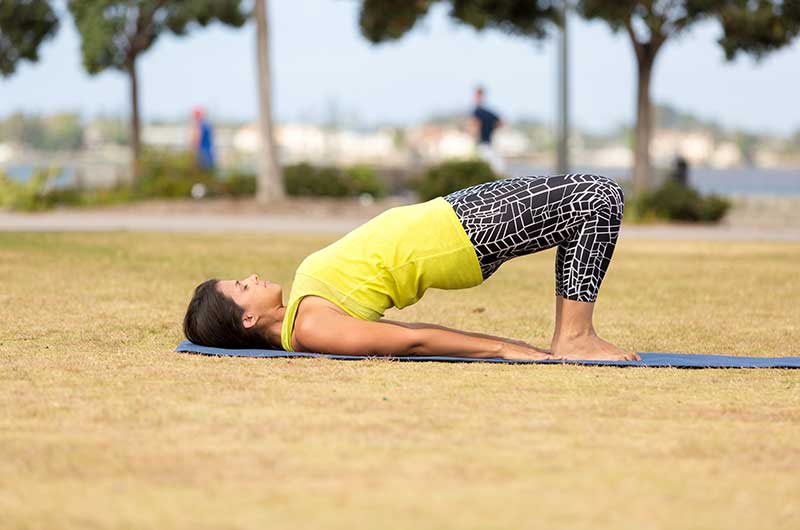
Lie on your back. Bend your knees and set your feet on the floor, hip-width apart. Lengthen your arms so your fingers reach toward your heels, palms facing down. Gaze toward your knees. Inhale and begin to roll up through the spine, starting with the hips. Roll as high as you can and hold for three to five breaths. Exhale and lower to the floor one vertebra at a time. Repeat one or two times.
Supine Twist
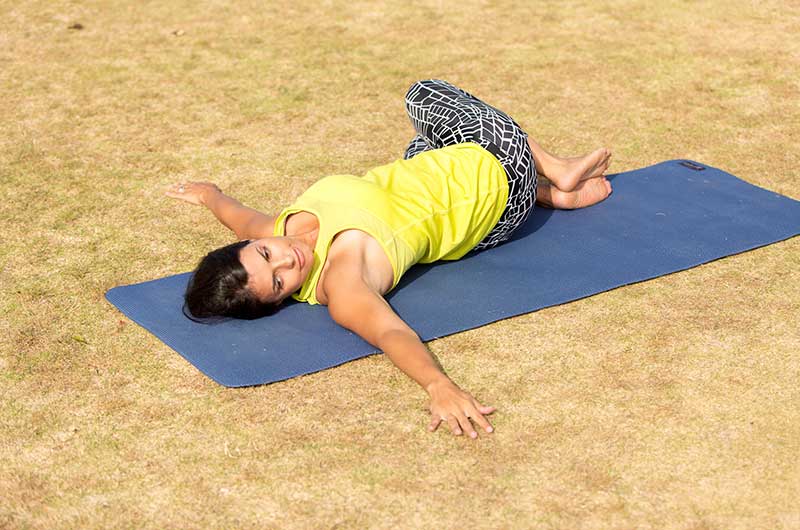
Pull your knees into your chest and then let your knees swing off to the left side. Extend your arms out from your shoulders, palms on the floor, into a T. Try to root your right shoulder into the floor and turn your gaze toward your right palm. Hold for five to 10 breaths and then switch sides.
Corpse Pose (Savasana)
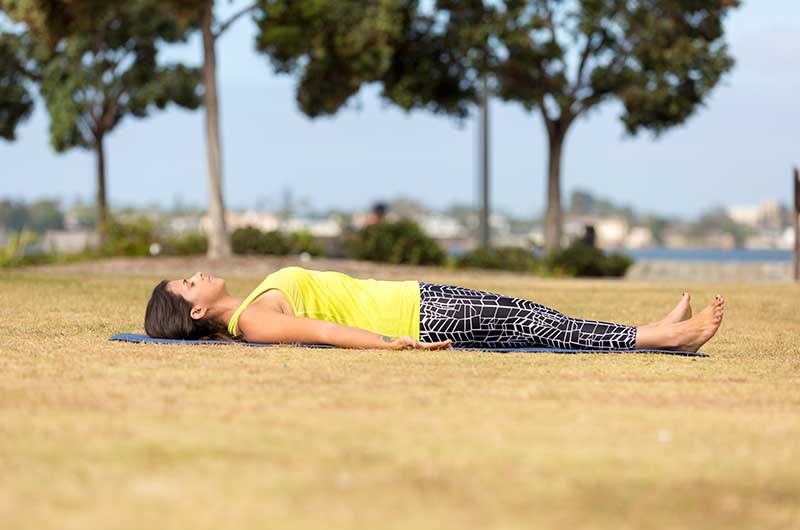
To complete your practice, come to this final resting pose. Extend your legs fully on your mat. Let your feet and thighs roll out and relax. Flip your palms to face the ceiling and relax your arms. Close your eyes and find stillness here for a few minutes.
Remember, It’s Not All About the Asana
Sure, a physical yoga practice is great for giving the body strength, flexibility and balance, but asana—the physical postures of yoga—is just one part of the whole yoga practice.
Beginning yogis often start with a physical practice, which becomes a gateway to other techniques, such as meditation or focused breathing, and these can be just as powerful as asana practice.
Sitting for a five-minute silent meditation first thing in the morning can start your day off in a calm and centered way. Adding five minutes of mindful breathing before bed can help give you a restful night’s sleep, and paying attention to your words and actions throughout the day is a wonderful way to slow down and take notice of your life.
Build Your Routine
Much like brushing your teeth or taking out the trash, establishing a regular yoga practice requires consistent effort. Start off with an easy, five-minute practice at a specific time each day, such as right before bed or first thing in the morning.
Base your practice on foundational poses, such as mountain pose (tadasana), tree pose (vriksasana), easy pose (sukhasana) and bridge pose (setu bandha sarvangasana). Practice your personal sequence, if not daily, at least three times a week. But don’t beat yourself up if you miss a day. Just start to build the practice into your daily life and it will soon become part of your routine.
Find Non-traditional Alternatives
There are many ways to find yoga outside the yoga studio. The Internet is a rich trove of free classes, tutorials and teachings from revered instructors. You can even subscribe to online services, such as YogaGlo or Ekhart Yoga, to access vast libraries of yoga and meditation classes. Podcasts—both audio and video—are also available to help your practice, such as those offered by YogaDownload. With these options, you can comfortably take a class anywhere you can access the Internet, whether that’s in your living room or a hotel room.




 by
by 








 by
by